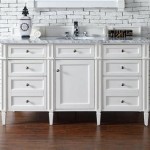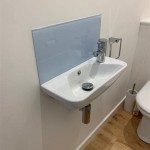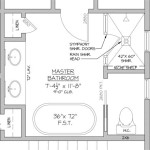What Is A Standard Bathroom Counter Height In Cm?
The height of a bathroom counter is an important consideration for both functionality and aesthetics. While there may be some flexibility in countertop height, the standard provides a comfortable and practical experience for most users. This article will discuss the standard bathroom counter height in centimeters and the factors that influence this measurement.
Standard Bathroom Counter Height in Centimeters
The standard bathroom counter height in centimeters is generally considered to be
85-91 cm (33.5-35.8 inches)
. This range allows for flexibility based on the specific needs of the user and the overall design of the bathroom. However, the ideal height may vary depending on the individual's height and the overall style of the bathroom.It is important to note that the standard bathroom counter height may not always be suitable for every individual. For example, individuals with limited mobility may find it challenging to reach a standard-height counter. In such cases, a lower counter height may be more appropriate. Conversely, taller individuals may prefer a higher counter height for greater comfort and ease of use.
Factors Influencing Bathroom Counter Height
Several factors can influence the choice of bathroom counter height. These factors include:
1. User Height
The height of the users is a primary factor influencing bathroom counter height. Taller individuals may prefer a higher counter to avoid having to stoop or bend over, while shorter users may find a lower counter more comfortable. Ideally, the counter should be at a height that allows the user to reach the sink without straining. A good rule of thumb is to position the counter at a height that is approximately 4-6 cm (1.5-2.5 inches) below the user's elbow height.
2. Sink Depth
The depth of the sink can also influence the overall counter height. A deeper sink may require a taller counter to ensure adequate space for the user to comfortably reach the sink and wash their hands. Conversely, a shallower sink may necessitate a lower counter. The counter should be high enough to provide sufficient clearance above the faucet and allow for comfortable hand washing.
3. Bathroom Design
The overall design of the bathroom can also play a role in determining the counter height. For example, in a small bathroom, a lower counter may be more practical to maximize space. In a larger bathroom, a higher counter may create a more luxurious and spacious feel.
4. Cabinetry
The height of the cabinet below the counter can also influence the overall counter height. The counter should be at a comfortable height for the user, even when considering the height of the cabinetry. If the cabinet is too high, it may create a difficult reach for the user, while a cabinet that is too low may result in a countertop that is too close to the floor. The cabinet and countertop should be well-proportioned to ensure a balanced and functional bathroom design.
Conclusion
The standard bathroom counter height is a crucial element that impacts the functionality and aesthetics of a bathroom. While the standard range of 85-91 cm (33.5-35.8 inches) provides a general guideline, it is essential to consider the specific needs of the users, the depth of the sink, the overall bathroom design, and the height of the cabinetry. By carefully evaluating these factors and considering the individual preferences of the users, you can ensure that the bathroom counter height is appropriate, comfortable, and aesthetically pleasing.

What Is The Standard Bathroom Vanity Height Size Guide

What Is The Standard Height Of A Bathroom Vanity 2024 Guide

What Is The Standard Bathroom Vanity Height Size Guide

What Is The Standard Height Of A Bathroom Vanity

What Is The Standard Height Of A Bathroom Vanity Sizes Cabinets Vessel Sink

What Is The Standard Height Of A Bathroom Vanity

What Is The Standard Bathroom Sink Height

What Is The Standard Height Of A Bathroom Vanity

What Is The Standard Height Of A Bathroom Vanity Sizes Cabinets Vessel Sink

Bathroom And Restroom Measurements Standards Guide
Related Posts







